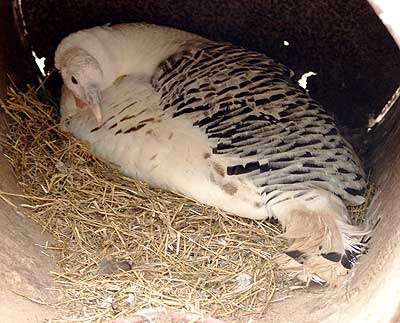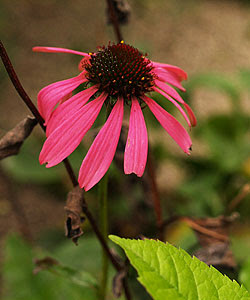 |
| "Marina di Chioggia" pumpkin. Photo Andrea Mangoni. |
When autumn comes, with the arrival of the first cold, the fruits that the vegetable garden give us start to change; the evenings getting longer and grows the desire of a nice fireplace. During this period, at least for me, pumpkins are the most representative fruits of the months of October and November. And among the hundreds of varieties of pumpkins, all extraordinary, different from each other in shapes, colors and sizes, my favorite is - absolutely - the "Marina di Chioggia" pumpkin.
 |
| The warty skin of the "Marina di Chioggia" pumpkin. Photo Andrea Mangoni. |
The "Marina di Chioggia" ("marine pumpkin of the Chioggia city"; Chioggia is a little city near Venice) is an italian heritage cultivare of pumpkin. It is not known exactly how this variety is grown in the area of Chioggia, in the province of Venice. The name "Marina" ("of the sea") was maybe give to this cultivar beacause once the families - that traditionally took care of the vegetable gardens near Venice and Chioggia - were those of the so-called "marinanti", different from those which were responsible directly for fishing and trade. It 'also known as "Holy Pumpkin" or "barucca pumpkin" or "scuffle", the term "barucca" deriving perhaps from "baruch", jewish word for "saint". Goldoni then immortalized in his famous "Baruffe chiozzotte" ("The Chioggia Barneys"). What is certain is that thanks to its excellent organoleptic characteristics and shelf life they becomes a key component of the canteen of coastal populations. His ability to settle for minimal land and increasing climbing allowed to use it to take advantage of otherwise unusable space for other crops. Indeed, apparently the salty environment of the venice lagoon favored the growth of more flavorful tasted specimens.
The fruits are ribbed, strongly flattened at the poles, with a thin skin that forms tubercles and growths that make it look like some strange prehistoric animal. Sometimes the navel can be very developed and it takes on the shape of a turban; also the stalk is usually big. Its size can be quite considerable, even several kilograms: an acquaintance told me about a really exceptional fruit that reached 12 kg, but, as St. Thomas, I don't believe if I don't see ... The flesh is yellow orange, with a fantastic taste, and lends itself to many preparations. Also the seeds, properly toasted, are a great snack.
 |
| "Marina di Chioggia" pumpkin cut in half. Photo Andrea Mangoni. |
The "Marina di Chioggia" is certainly a very ancient cultivar. In the old Cherubini's dictionary "Vocabulario Milanese - Italiano" (1841) we find this pumpkin cited as::
Zucca barucca. Zucca dal collo torto ? o ritorta o di Chiozza. (Barucca pumpkin. Wrong-necked pumpkin? or twisted pumpkin or Chiozza pumpkin).
Even in Tanarsa's "L'economia del cittadino in villa" ("The economy of the cityzen in town"), 1658, Marina pumpkin is cited as "exquisite." Even earlier, in "Il Panonto - Dottrina sigolare di Domenico M. Romo" ("The Panonto - Singular doctrine of Domenico M. Romo"), 1637, are cited various preparations and food pairings that included this vegetable, such as fried marine pumpkin with green sauce, combined with lemons, elder fried flowers, little squids, omelettes, and many other foods. A set of dishes that even if older than four centuries, in fact, do not lose effectiveness or taste.
 |
| "Marina di Chioggia" pumpkin. Photo Andrea Mangoni. |
The "Marina di Chioggia" pumpkin is sown in March here in Italy, as most of the varieties, and comes to mature in September-October. The seeds should be placed at 1 cm depth in the soil, individually in jars of appropriate size. They could be also directly planted on field in april. Although it is traditionally grown in poor soil, in the past I had the best results growing it directly behind the compost pile, so that the roots and the base of the stem were mostly in the shade and that instead the stem and the leaves was climbing on the chain-link fence, facing south-west. In my vegetable garden, the plants produced 2-3 very large pumpkin, and some smaller fruits. Look at the chickens, they will eat each bud they could. Some years ago an elder farmer of Chioggia gave me the seeds just saying that belonged to this variety, once planted them i was disapponted to find out that they had nothing to do with it. So this year I chose at the vegetable market a beautiful Marina pumpkin, and ready to use in the kitchen I have put aside the seeds for next year. For the record, the "model" of the photo below has been transformed (thanks to the tireless work of my wife) in pumpkin soup, with pasta, olive oil and cheese, slices of pumpkin fried in batter, accompanied by Asiago and Grana Padano cheese, and finally in a beautiful, and delicious, pumpkin pie. We had to sacrifice even to determine whether it was really good as well as said, right? Now we can confirm this: the pumpkin "Marina di Chioggia" pumpkin is fantastic!
SUGGESTED READINGS
.
.
































